Family name: Fabaceae J. Lindley or Leguminosae Jussieu
Synonym(s): Acaciaceae E. Mey.; Aspalathaceae Martinov; Astragalaceae Bercht. & J. Presl; Caesalpiniaceae R. Br., nom. cons.; Cassiaceae Vest; Ceratoniaceae Link; Detariaceae Hess; Hedysaraceae Bercht. & J. Presl; Inocarpaceae Zoll.; Leguminosae Juss., nom. cons.; Mimosaceae R. Br., nom. cons.; Papilionaceae Giseke, nom. cons.; Phaseolaceae Mart.; Swartziaceae Bartl.; Viciaceae Oken
Common Name(s): legumelegume:
a usually dry, dehiscent fruit derived from a single carpel that opens along two longitudinal sutures, derived from a single, superior, simple ovary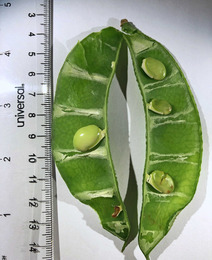 family
family
*Number of genera/species: 798/19,500
List of genera records in GRIN-Global. See also image gallery on GRIN-Global
Fruits and Seeds of Legume Genera of the World provides a key and detailed descriptions of all Fabaceae genera.
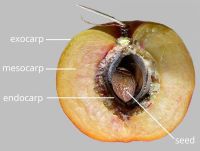 or endocarpendocarp:
or endocarpendocarp: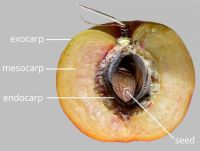 exposed), or seed
exposed), or seed
Fruit usually a unilocular legumelegume:
a usually dry, dehiscent fruit derived from a single carpel that opens along two longitudinal sutures, derived from a single, superior, simple ovary , sometimes lomentloment:
, sometimes lomentloment:
a usually dry fruit derived from a single carpel that breaks transversely into one-seeded fruit segments, derived from a single, superior, simple ovary (actively or passively dehiscentdehiscent:
(actively or passively dehiscentdehiscent:
(v. dehisce) splitting open at maturity to release contents (of a fruit)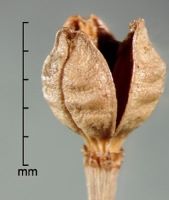 ) or sometimes an acheneachene:
) or sometimes an acheneachene:
a dry, indehiscent, one-seeded fruit, with seed attached to pericarp at a single point, derived from a single, superior, simple or compound, one-loculed ovary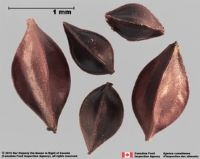 , rarely a pod or samarasamara:
, rarely a pod or samarasamara:
a winged, indehiscent, dry fruit containing a single (rarely two) seed(s)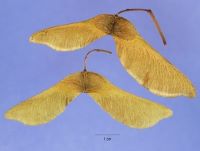 , 1–600 mm long (up to 2000 mm in Entada), variable in shape, often ellipsoidellipsoid:
, 1–600 mm long (up to 2000 mm in Entada), variable in shape, often ellipsoidellipsoid:
3D shape—elliptic
to linearlinear:
(shape) long, narrow, and uniform in width; (of embryo) embryo is straight and much longer than wide , prior to dehiscence majority of genera have straight fruits, some are folded, twisted, curvedcurved:
, prior to dehiscence majority of genera have straight fruits, some are folded, twisted, curvedcurved:
(of embryo) linear embryo is curved into an arch or horseshoe with the ends far apart , or coiledcoiled:
, or coiledcoiled:
(of embryo) linear embryo is very long and bent to form a coil whereby one end of the embryo is on the outside and the other end near the middle of the seed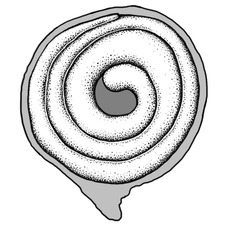 , usually compressedcompressed:
, usually compressedcompressed:
flattened; in grasses, used to denote compression (not necessarily flattened) either laterally or dorsiventrally
in transection, beakedbeak:
a usually firm, terminal appendage, sometimes tapered or not, stylestyle:
or not, stylestyle:
in a flower, the narrow and elongated part of the pistil between the stigma and the ovary; sometimes persisting in fruit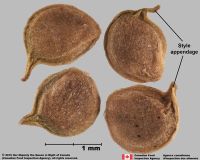 often persistent, sometimes winged, with one (lomentloment:
often persistent, sometimes winged, with one (lomentloment:
a usually dry fruit derived from a single carpel that breaks transversely into one-seeded fruit segments, derived from a single, superior, simple ovary segments or achenesachene:
segments or achenesachene:
a dry, indehiscent, one-seeded fruit, with seed attached to pericarp at a single point, derived from a single, superior, simple or compound, one-loculed ovary ) to many seeds, rarely enclosed by persistent perianthperianth:
) to many seeds, rarely enclosed by persistent perianthperianth:
collective term for calyx and corolla of a flower
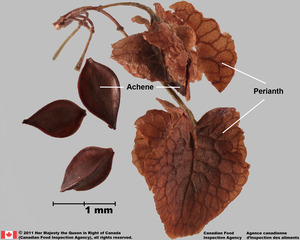 (loose, utricle-like or tight, achene-like). Fruits sometimes subtended by accrescentaccrescent:
(loose, utricle-like or tight, achene-like). Fruits sometimes subtended by accrescentaccrescent:
growing continuously
, persistent calyxcalyx:
the outer whorl of the perianth; all the sepals of a flower . Pericarppericarp:
. Pericarppericarp:
fruit wall or fruit coat
usually black or brown, sometimes gray, green, yellow, orange, purple, or red, usually monochrome, sometimes bichrome, mottledmottled:
with colored spots, streaks, or blotches of a different color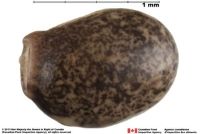 , or streaked, shinyshiny:
, or streaked, shinyshiny:
uniformly reflecting a high proportion of incident light at all angles or dulldull:
or dulldull:
reflecting only a low proportion of incident light, with no apparent sheen , leatheryleathery:
, leatheryleathery:
texture—moderately thick, tough, and very pliable
or chartaceouschartaceous:
papery, papyraceous
, sometimes woodywoody:
texture—consisting mainly of indurate lignified tissues, characteristic of or resembling wood
or membranousmembranous:
texture—extremely thin, pliable, and fairly tough
, rarely fleshy, glabrousglabrous:
without hairs
or not, usually smooth or variously sculptured. Mesocarpmesocarp:
the middle layer of the pericarp, if divided into layers usually present, fleshy (including spongyspongy:
usually present, fleshy (including spongyspongy:
soft, light, discontinuous but cohesive, and somewhat resilient
and pulpy), woodywoody:
texture—consisting mainly of indurate lignified tissues, characteristic of or resembling wood
, bonybony:
very hard and rather brittle, like bone
, or fibrousfibrous:
texture -- long, flexible threads, thicker than hairs, that densely cover and obscure the surface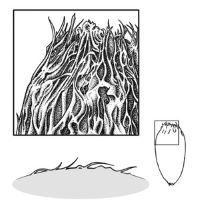 . Endocarpendocarp:
. Endocarpendocarp:
the inner layer of the pericarp, if divided into layers , usually present and separating at dehiscence, thin, woodywoody:
, usually present and separating at dehiscence, thin, woodywoody:
texture—consisting mainly of indurate lignified tissues, characteristic of or resembling wood
, or bonybony:
very hard and rather brittle, like bone
, septateseptate:
structure with one or more septa
or not. A short or long funiculusfuniculus:
(alt. funicle) stalk connecting the ovule (later seed) to the ovary (later fruit) placenta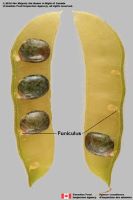 (to 50 mm long) is often visible and sometimes persistent after seeds are shed.
(to 50 mm long) is often visible and sometimes persistent after seeds are shed.
Seeds usually reniformreniform:
2D or 3D shape—kidney-shaped or globoseglobose:
or globoseglobose:
3D shape—more or less spherical , compressedcompressed:
, compressedcompressed:
flattened; in grasses, used to denote compression (not necessarily flattened) either laterally or dorsiventrally
to tereteterete:
approximately circular in cross section; width and thickness approximately equal
 in transection, 0.5–180 mm long. Rapheraphe:
in transection, 0.5–180 mm long. Rapheraphe:
a ridge or seam on the seed coat, formed by the portion of the funiculus united to the ovule wall in longitudinally curved ovules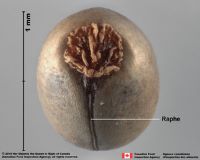 often conspicuous. Seeds sometimes winged. ArilsAril:
often conspicuous. Seeds sometimes winged. ArilsAril:
(broad sense) appendicular structure that wholly or partly envelops a seed and is produced from or a modification of the funicle, raphe, or outer integument; usually fleshy or pulpy, sometimes spongy or tufted-capillate, often brightly colored often present, or remnants present and may obscure hilahilum:
often present, or remnants present and may obscure hilahilum:
on seeds, the scar indicating where the funiculus was attached; on grass caryopses, the scar visible on the outer fruit surface revealing where the seed is attached on the inner fruit wall surface; or in Asteraceae cypselae, the scar visible on the outer fruit wall revealing where the fruit was attached to the receptacle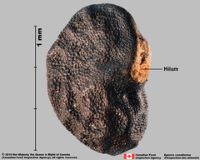 , fleshy or dry, basalbasal:
, fleshy or dry, basalbasal:
at or pertaining to the point of attachment; (of embryo) embryo occupies one end of the seed
, marginalmarginal:
at, on, or close to the margin or border
, or encompassing seeds, annularannular:
3D shape—forming a ring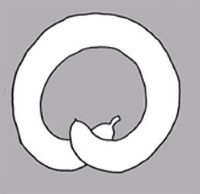 to cup-shaped. Seed coat usually brown or brown in combination with other colors, sometimes mottledmottled:
to cup-shaped. Seed coat usually brown or brown in combination with other colors, sometimes mottledmottled:
with colored spots, streaks, or blotches of a different color or streaked, dulldull:
or streaked, dulldull:
reflecting only a low proportion of incident light, with no apparent sheen or glossyglossy:
or glossyglossy:
shiny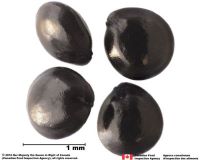 , often firm or bonybony:
, often firm or bonybony:
very hard and rather brittle, like bone
, glabrousglabrous:
without hairs
, usually appearing smooth, especially at low magnification, often with fold or notch between cotyledons and hypocotyl-radicle. Sometimes pleurogrampleurogram:
a U-shaped line on both seed faces resulting from a gaping break in the outer seed coat cells (exotestal palisades), present in Fabaceae subfamilies Mimosoideae and Caesalpinioideae or pseudopleurogrampseudopleurogram:
or pseudopleurogrampseudopleurogram:
a colored line visible on the seed coat that appears like the pleurogram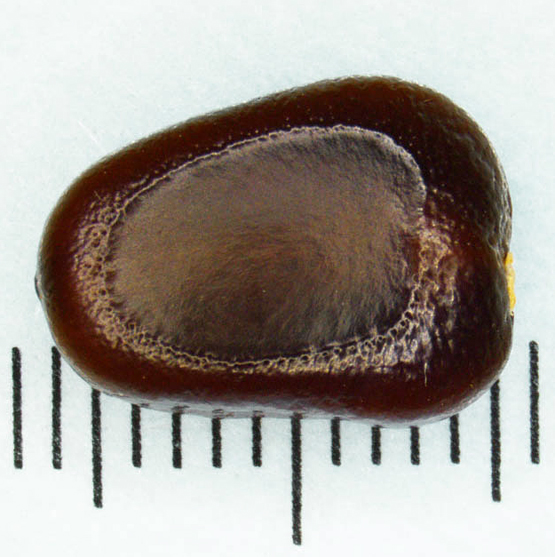 present. HilaHilum:
present. HilaHilum:
on seeds, the scar indicating where the funiculus was attached; on grass caryopses, the scar visible on the outer fruit surface revealing where the seed is attached on the inner fruit wall surface; or in Asteraceae cypselae, the scar visible on the outer fruit wall revealing where the fruit was attached to the receptacle punctate or larger than punctatepunctate:
punctate or larger than punctatepunctate:
surface relief—dotted with pits or with translucent, sunken glands or with colored dots, similar to pitted (0.3 mm or more diam. x 0.1–9 mm long, rarely longer than 10 mm), circularcircular:
(0.3 mm or more diam. x 0.1–9 mm long, rarely longer than 10 mm), circularcircular:
(of embryo) linear embryo is curved into an "O" shape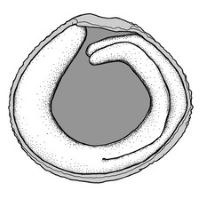 to linearlinear:
to linearlinear:
(shape) long, narrow, and uniform in width; (of embryo) embryo is straight and much longer than wide , sometimes irregular, often with median groove.
, sometimes irregular, often with median groove.
Embryo well developed, usually completely filling seed coat, sometimes green, axileaxile:
on or of the axis
and centric, foliatefoliate:
appearing leaf-like
, usually curvedcurved:
(of embryo) linear embryo is curved into an arch or horseshoe with the ends far apart , hypocotyl-radicle straight, coiledcoiled:
, hypocotyl-radicle straight, coiledcoiled:
(of embryo) linear embryo is very long and bent to form a coil whereby one end of the embryo is on the outside and the other end near the middle of the seed , or curvedcurved:
, or curvedcurved:
(of embryo) linear embryo is curved into an arch or horseshoe with the ends far apart . Cotyledons investinginvesting:
. Cotyledons investinginvesting:
(of embryo) embryo is nearly or completely filling seed coat, straight, and axile and centric with spatulate cotyledons and covering the stalk for at least half its length; (of cotyledons) cotyledons spatulate and covering the stalk for at least half its length
to spatulatespatulate:
2D shape—like a spatula; rounded at the apex, with base long and tapered; (of embryo) embryo is straight and axile and centric with the cotyledons expanded to form the shape of a spatula or spoon; (of cotyledons) cotyledons expanded and wider than the stalk but not invested into the stalk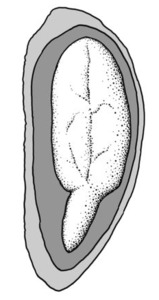 , thin to moderately flat, entire or cordatecordate:
, thin to moderately flat, entire or cordatecordate:
2D shape—heart-shaped, with attachment at or near the broad end (compare obcordate)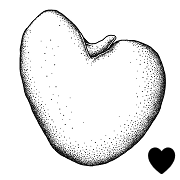 . Internal structures relative size and shape often useful in identification to species.
. Internal structures relative size and shape often useful in identification to species.
Endosperm absent, rarely copious.
Noxious Weeds: USA Federal Noxious Weed List, all terrestrial, Galega officinalis Linnaeus; Mimosa diplotricha C. Wright; M. pigra L. var pigra; Neltuma alpataco (Phil.) C. E. Hughes & G. P. Lewis (=*Prosopis alpataco Phil.); N. argentina (Burkart) C. E. Hughes & G. P. Lewis (=*P. argentina Burkart); N. articulata (S. Watson) C. E. Hughes & G. P. Lewis (=*P. articulata S. Watson); N. caldenia (Burkart) C. E. Hughes & G. P. Lewis (=*P. caldenia Burkart); N. calingastana (Burkart) C. E. Hughes & G. P. Lewis (=*P. calingastana Burkart); N. campestris (Griseb.) C. E. Hughes & G. P. Lewis (=*P. campestris Griseback); N. castellanosii (Burkart) C. E. Hughes & G. P. Lewis (=*P. castellanosii Burkart); N. denudans (Benth.) C. E. Hughes & G. P. Lewis (=*Prosopis denudans Bentham); N. elata (Burkart) C. E. Hughes & G. P. Lewis (=*P. elata (Burkart) Burkart); N. fiebrigii (Harms) C. E. Hughes & G. P. Lewis (=*P. fiebrigii Harms); N. hassleri (Harms) C. E. Hughes & G. P. Lewis (=*P. hassleri Harms); N. humilis (Gillies ex Hooker & Grev.) C. E. Hughes & G. P. Lewis (=*P. humilis Gillies ex Hooker & Arnott); N. kuntzei (Harms ex Kuntze) C. E. Hughes & G. P. Lewis (=*P. kuntzei Harms); N. pallida (Humb. & Bonpl. ex Willd.) C. E. Hughes & G. P. Lewis (=*P. pallida (Humboldt & Bonpland ex Willdenow) Kunth); Neltuma rojasiana (Burkart) C. E. Hughes & G. P. Lewis (=*P. rojasiana Burkart); N. ruizlealii (Burkart) C. E. Hughes & G. P. Lewis (=*P. ruizlealii Burkart); N. ruscifolia (Griseb.) C. E. Hughes & G. P. Lewis (=*P. ruscifolia Grisebach); N. sericantha (Gillies ex Hooker) C. E. Hughes & G. P. Lewis (=*P. sericantha Gillies ex Hooker & Arnott); Prosopis farcta (Banks & Solander) J.F. Macbride; Strombocarpa burkartii (Muñoz) C. E. Hughes & G. P. Lewis (=*P. burkartii Munoz); S. ferox (Griseb.) C. E. Hughes & G. P. Lewis(=*P. ferox Grisebach); S. palmeri (S. Watson) C. E. Hughes & G. P. Lewis (=*P. palmeri S. Watson); S. reptans (Benth.) A. Gray (=*Prosopis reptans Bentham var. reptans); S. strombulifera (Lam.) A. Gray (=*P. strombulifera (Lamarck) Bentham); S. torquata (Cav. ex Lag.) C. E. Hughes & G. P. Lewis (=*P. torquata (Cavanilles ex Lagasca y Segura) de Candolle); Vachellia nilotica (L.) P.J.H.Hurter & Mabb.(=*Acacia nilotica (Linnaeus) Wildenow ex Delile).
*Name listed in USA Federal Noxious Weed Regulations and tool linked below.
Federal Noxious Weed Disseminules of the US tool provides keys, descriptions, and images of these species. Aquarium & Pond Plants of the World tool includes descriptions and images of genera, which may be encountered.
| Fruit | |
| Type | legumelegume: a usually dry, dehiscent fruit derived from a single carpel that opens along two longitudinal sutures, derived from a single, superior, simple ovary  , lomentloment: , lomentloment:a usually dry fruit derived from a single carpel that breaks transversely into one-seeded fruit segments, derived from a single, superior, simple ovary  , acheneachene: , acheneachene:a dry, indehiscent, one-seeded fruit, with seed attached to pericarp at a single point, derived from a single, superior, simple or compound, one-loculed ovary  , indehiscentindehiscent: , indehiscentindehiscent:not opening on its own, as in a fruit 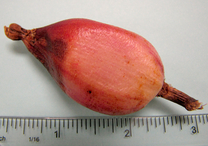 pod, samarasamara: pod, samarasamara:a winged, indehiscent, dry fruit containing a single (rarely two) seed(s)  |
| Size range | 1–600 (–2000) mm long |
| Shape(s) | ellipsoidellipsoid: 3D shape—elliptic , fusiformfusiform: spindle-shaped; broadest at the middle and tapering at both ends 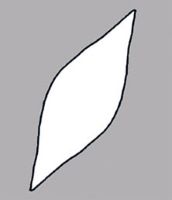 , linearlinear: , linearlinear:(shape) long, narrow, and uniform in width; (of embryo) embryo is straight and much longer than wide  , lanceoloidlanceoloid: , lanceoloidlanceoloid:3D shape—lanceolate , oblongoblong: 2D shape—much longer than broad with nearly parallel sides, corners are rounded  , ovoidovoid: , ovoidovoid:3D shape—ovate  , dolabriformdolabriform: , dolabriformdolabriform:3D shape—axe-shaped, elongate, basally terete, becoming strongly compressed toward an abruptly and unilaterally broader apex , harp-shaped, irregular, didymousdidymous: 3D shape—paired, usually inflated and appears as two globose to ovoid halves pressed together , moniliformmoniliform: elongate, relatively slender, transversely round, and more or less regularly constricted over its length, the whole straight or variously curved; like a necklace of beads, see torulose 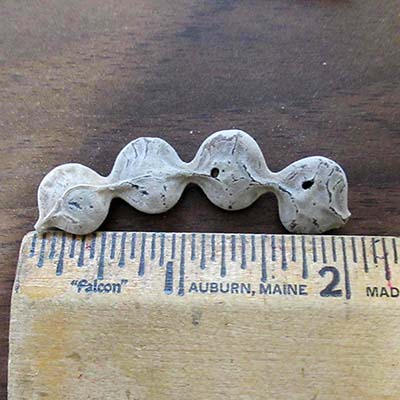 , angledangular: , angledangular:2D shape—having sides that meet at acute or obtuse angles (quandrangular or rectangular), rhomboid, triangulartriangular: 2D shape—three relatively straight sides with distinct corners; more angular than teardrop-shaped  , reniformreniform: , reniformreniform:2D or 3D shape—kidney-shaped  , falcatefalcate: , falcatefalcate:shaped like a scythe or sickle  , C-shapedC-shaped: , C-shapedC-shaped:2D-shape—semiannulate, curved into the shape of the letter 'C' , circularcircular: (of embryo) linear embryo is curved into an "O" shape  , coiledcoiled: , coiledcoiled:(of embryo) linear embryo is very long and bent to form a coil whereby one end of the embryo is on the outside and the other end near the middle of the seed  , S-shaped , S-shaped |
| Texture | woodywoody: texture—consisting mainly of indurate lignified tissues, characteristic of or resembling wood , leatheryleathery: texture—moderately thick, tough, and very pliable , chartaceouschartaceous: papery, papyraceous , membranousmembranous: texture—extremely thin, pliable, and fairly tough , rarely fleshy |
| Surface relief | smooth, groovedgrooved: surface relief—linear depressions that may be single or form a series of grooves over the surface 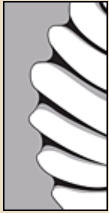 , ribbedribbed: , ribbedribbed:surface relief—wide, prominent, linear ridges that are generally rounded and longitudinally situated on the surface  , reticulatereticulate: , reticulatereticulate:surface relief—netted, raised walls or concave grooves forming a net-like surface pattern with flat, concave, or convex interspaces  , wrinkledwrinkled: , wrinkledwrinkled:surface relief—shallow, irregular folds and furrows covering the surface; appearing overall though crumpled and then spread out  , veinedveined: , veinedveined:surface relief—lines that intersect in a vein pattern that is flush or slightly raised from the surface 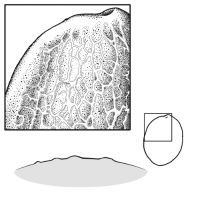 , tuberculatetuberculate: , tuberculatetuberculate:surface relief—bearing small, warty, swelling, rounded, or variously shaped projections 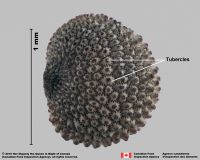 , blisteredblistered: , blisteredblistered:surface relief—covered with irregular raised, hollow granules that give the surface a bubbled appearance 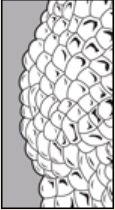 , papillosepapillate: , papillosepapillate:surface relief—bearing minute, distinct, broad-based projections, tapering to a rounded apex  , pustulatepustular: , pustulatepustular:surface relief—with small blisters or pustules 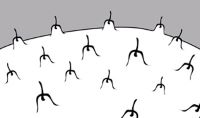 , scurfy, prickly, spinyspiny: , scurfy, prickly, spinyspiny:having slender, stiff, sharp projections oriented in the general plane of the structure  , or with glandularglandular: , or with glandularglandular:surface relief—covered with small, raised secretory glands, regular or irregularly shaped, translucent or opaque, and maybe distinctly colored  discs or dots discs or dots |
| Color(s) | usually black or brown, sometimes gray, green, yellow, orange, purple, or red, sometimes bichrome, mottledmottled: with colored spots, streaks, or blotches of a different color  , or streaked , or streaked |
| Unique features | Usually legumeslegume: a usually dry, dehiscent fruit derived from a single carpel that opens along two longitudinal sutures, derived from a single, superior, simple ovary  , dehiscing along one or both sutures, with hard coated, globoseglobose: , dehiscing along one or both sutures, with hard coated, globoseglobose:3D shape—more or less spherical  to reniformreniform: to reniformreniform:2D or 3D shape—kidney-shaped  seeds with visible hilahilum: seeds with visible hilahilum:on seeds, the scar indicating where the funiculus was attached; on grass caryopses, the scar visible on the outer fruit surface revealing where the seed is attached on the inner fruit wall surface; or in Asteraceae cypselae, the scar visible on the outer fruit wall revealing where the fruit was attached to the receptacle  , often larger than punctatepunctate: , often larger than punctatepunctate:surface relief—dotted with pits or with translucent, sunken glands or with colored dots, similar to pitted  . . |
| Seed | |
| Size range | 0.5–180 mm long |
| Shape(s) | most commonly reniformreniform: 2D or 3D shape—kidney-shaped  , also lens-shapedlens-shaped: , also lens-shapedlens-shaped:2D shape—round and flattened with two curved (convex) surfaces , globoseglobose: 3D shape—more or less spherical  , ellipsoidellipsoid: , ellipsoidellipsoid:3D shape—elliptic , linearlinear: (shape) long, narrow, and uniform in width; (of embryo) embryo is straight and much longer than wide  , oblongoblong: , oblongoblong:2D shape—much longer than broad with nearly parallel sides, corners are rounded  , ovoidovoid: , ovoidovoid:3D shape—ovate  , pear-shaped, bilobed, falcatefalcate: , pear-shaped, bilobed, falcatefalcate:shaped like a scythe or sickle  , C-shapedC-shaped: , C-shapedC-shaped:2D-shape—semiannulate, curved into the shape of the letter 'C' , cordatecordate: 2D shape—heart-shaped, with attachment at or near the broad end (compare obcordate)  , D-shapedD-shaped: , D-shapedD-shaped:2D shape—has one straight margin and one curved margin, resembling the shape of the letter D , hippocrepiformhippocrepiform: 3D shape—horseshoe-shaped , angledangular: 2D shape—having sides that meet at acute or obtuse angles (quandrangular or rectangular), rhomboid, triangulartriangular: 2D shape—three relatively straight sides with distinct corners; more angular than teardrop-shaped  , irregular, mitaformmitaform: , irregular, mitaformmitaform:shaped like a child's mitten |
| Surface relief | usually smooth, sometimes smooth, groovedgrooved: surface relief—linear depressions that may be single or form a series of grooves over the surface  , ridgedridged: , ridgedridged:surface relief—raised, thick ridges, sharp edged or rounded, usually in a series that may cover the entire surface 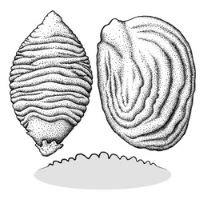 , wrinkledwrinkled: , wrinkledwrinkled:surface relief—shallow, irregular folds and furrows covering the surface; appearing overall though crumpled and then spread out  , pittedpitted: , pittedpitted:surface relief—surface with small depressions in which the areas between the hollows do not take on the appearance of a true reticular net  , striatestriate: , striatestriate:surface relief—having fine, parallel lines, grooves or ridges  , cracked, wartywarty: , cracked, wartywarty:surface relief—distinct, rounded projections that are large relative to the fruit size; tuberculate, verrucose  , echinate, papillatepapillate: , echinate, papillatepapillate:surface relief—bearing minute, distinct, broad-based projections, tapering to a rounded apex  |
| Color(s) | brown or brown in combination with other colors, rarely black, blue, gray, green, olive, yellow, orange, red, purple, red, scarlet, or white, sometimes mottledmottled: with colored spots, streaks, or blotches of a different color  or streaked or streaked |
| Unique features | Brown, hard-coated, smooth reniformreniform: 2D or 3D shape—kidney-shaped  or lens-shapedlens-shaped: or lens-shapedlens-shaped:2D shape—round and flattened with two curved (convex) surfaces seeds with visible punctatepunctate: surface relief—dotted with pits or with translucent, sunken glands or with colored dots, similar to pitted  or larger than punctatepunctate: or larger than punctatepunctate:surface relief—dotted with pits or with translucent, sunken glands or with colored dots, similar to pitted  hilahilum: hilahilum:on seeds, the scar indicating where the funiculus was attached; on grass caryopses, the scar visible on the outer fruit surface revealing where the seed is attached on the inner fruit wall surface; or in Asteraceae cypselae, the scar visible on the outer fruit wall revealing where the fruit was attached to the receptacle  and embryo completely to nearly filling seed coat. If hilahilum: and embryo completely to nearly filling seed coat. If hilahilum:on seeds, the scar indicating where the funiculus was attached; on grass caryopses, the scar visible on the outer fruit surface revealing where the seed is attached on the inner fruit wall surface; or in Asteraceae cypselae, the scar visible on the outer fruit wall revealing where the fruit was attached to the receptacle  larger than punctatepunctate: larger than punctatepunctate:surface relief—dotted with pits or with translucent, sunken glands or with colored dots, similar to pitted  , then usually with a distinct cleft or line bisecting it. Seeds sometimes arillate or with U-shaped line on the faces. , then usually with a distinct cleft or line bisecting it. Seeds sometimes arillate or with U-shaped line on the faces. |
| Other | |
| Embryo | well developed, usually completely filling seed coat, sometimes green, axileaxile: on or of the axis and centric, foliatefoliate: appearing leaf-like , usually curvedcurved: (of embryo) linear embryo is curved into an arch or horseshoe with the ends far apart  , hypocotyl-radicle straight, coiledcoiled: , hypocotyl-radicle straight, coiledcoiled:(of embryo) linear embryo is very long and bent to form a coil whereby one end of the embryo is on the outside and the other end near the middle of the seed  , or curvedcurved: , or curvedcurved:(of embryo) linear embryo is curved into an arch or horseshoe with the ends far apart  . Cotyledons investinginvesting: . Cotyledons investinginvesting:(of embryo) embryo is nearly or completely filling seed coat, straight, and axile and centric with spatulate cotyledons and covering the stalk for at least half its length; (of cotyledons) cotyledons spatulate and covering the stalk for at least half its length to spatulatespatulate: 2D shape—like a spatula; rounded at the apex, with base long and tapered; (of embryo) embryo is straight and axile and centric with the cotyledons expanded to form the shape of a spatula or spoon; (of cotyledons) cotyledons expanded and wider than the stalk but not invested into the stalk  , thin to moderately flat, entire or cordatecordate: , thin to moderately flat, entire or cordatecordate:2D shape—heart-shaped, with attachment at or near the broad end (compare obcordate)  . Internal structures relative size and shape often useful in identification to species. . Internal structures relative size and shape often useful in identification to species. |
| Nutritive tissue | endosperm absent, rarely copious |
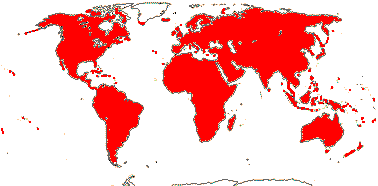
Distribution map courtesy of Angiosperm Phylogeny Website.
Gunn 1984Gunn 1984:
Gunn CR. 1984. Fruits and seeds of genera in the subfamily Mimosoideae (Fabaceae). Technical Bulletin USDA 1681:1&-194.; Gunn 1991Gunn 1991:
Gunn CR. 1991. Fruits and seeds of genera in the subfamily Caesalpinioideae (Fabaceae). Technical Bulletin USDA 1755:1&-408.; Kirkbride et al. 2003Kirkbride et al. 2003:
Kirkbride JH Jr, Gunn CR, and Weitzman AL. 2003. Fruits and seeds of genera in the subfamily Faboideae (Fabacerae). Technical Bulletin USDA 1890:1–1208.; Kirkbride et al. 2006Kirkbride et al. 2006:
Kirkbride JH, Jr, Gunn CR, and Dallwitz MJ. 2006. Family guide for fruits and seeds, vers. 1.0. Accessed September 2020-January 2022. URL: https://nt.ars-grin.gov/seedsfruits/keys/frsdfam/index.cfm .; Lionakis Meyer and Price 2021Lionakis Meyer and Price 2021:
Lionakis Meyer DJ and Price RA. 2021. Identification Guide to Large-seeded Members of the Subfamily Faboideae (Fabaceae). California Department of Food and Agriculture Plant Pest Diagnostics Center &- Seed Science Laboratory Sacramento, California. https://analyzeseeds.com/wp-content/uploads/2021/05/Fabaceae-large-seeded-legumes-2021.pdf; Noxious Weed Regulations 2020Noxious Weed Regulations 2020:
Noxious Weed Regulations. 2020. 7 C.F.R. sect; 360.100-360.600.; USDA 1980USDA 1980:
United States Dept. of Agriculture (USDA). 1980. Major weed family identification guide. Hyattsville Md, United States ; Takhtajan 2009Takhtajan 2009:
Takhtajan A. 2009. Flowering plants: Second edition. Springer Nature, Switzerland. 871 pp.
*The number of genera and species is based on Christenhusz and Byng 2016Christenhusz and Byng 2016:
Christenhusz MJM and Byng JW. 2016. The number of known plant species in the world and its annual increase. Phytotaxa 261 (3): 201-217. https://doi.org/10.11646/phytotaxa.261.3.1, which may differ from the number of genera in GRIN-Global.